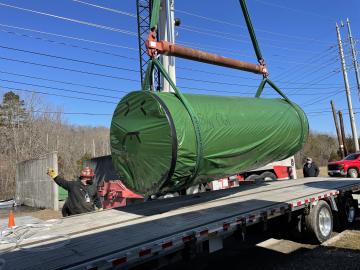Filter News
Area of Research
- (-) Clean Energy (69)
- (-) Supercomputing (21)
- Advanced Manufacturing (7)
- Biology and Environment (37)
- Building Technologies (1)
- Computational Biology (1)
- Computational Engineering (2)
- Computer Science (4)
- Electricity and Smart Grid (1)
- Fusion and Fission (14)
- Fusion Energy (1)
- Isotopes (12)
- Materials (15)
- Materials for Computing (18)
- Mathematics (1)
- National Security (7)
- Neutron Science (16)
- Nuclear Science and Technology (1)
- Quantum information Science (3)
- Sensors and Controls (1)
- Transportation Systems (1)
News Topics
- 3-D Printing/Advanced Manufacturing (24)
- Advanced Reactors (1)
- Artificial Intelligence (4)
- Big Data (3)
- Bioenergy (3)
- Biology (6)
- Biomedical (1)
- Biotechnology (1)
- Buildings (12)
- Chemical Sciences (2)
- Clean Water (1)
- Climate Change (6)
- Composites (5)
- Computer Science (18)
- Coronavirus (4)
- Critical Materials (3)
- Cybersecurity (2)
- Decarbonization (5)
- Energy Storage (21)
- Environment (15)
- Frontier (3)
- Grid (8)
- High-Performance Computing (11)
- Machine Learning (1)
- Materials (17)
- Materials Science (9)
- Mathematics (1)
- Microscopy (3)
- Nanotechnology (3)
- National Security (1)
- Net Zero (1)
- Neutron Science (4)
- Nuclear Energy (1)
- Physics (1)
- Polymers (3)
- Quantum Computing (5)
- Quantum Science (3)
- Security (1)
- Space Exploration (1)
- Statistics (1)
- Summit (5)
- Sustainable Energy (24)
- Transportation (17)
Media Contacts

Marm Dixit, a Weinberg Distinguished Staff Fellow in the Emerging and Solid-State Batteries Group at ORNL, has been awarded a Toyota Young Investigator Fellowship for Projects in Green Energy Technology from the Electrochemical Society.

Nearly a billion acres of land in the United States is dedicated to agriculture, producing more than a trillion dollars of food products to feed the country and the world. Those same agricultural processes, however, also produced an estimated 700 million metric tons of carbon dioxide equivalent in 2018, according to the U.S. Department of Agriculture.

An international problem like climate change needs solutions that cross boundaries, both on maps and among disciplines. Oak Ridge National Laboratory computational scientist Deeksha Rastogi embodies that approach.

When Hope Corsair’s new colleagues at Oak Ridge National Laboratory ask her about her area of expertise, she tells them it’s “context.” Her goal as an energy economist is to make sure ORNL’s breakthroughs have the widest possible

Oak Ridge National Laboratory researchers demonstrated that cooling cost savings could be achieved with a 3D printed concrete smart wall following a three-month field test.

ORNL has licensed its wireless charging technology for electric vehicles to Brooklyn-based HEVO. The system provides the world’s highest power levels in the smallest package and could one day enable electric vehicles to be charged as they are driven at highway speeds.

Improved data, models and analyses from ORNL scientists and many other researchers in the latest global climate assessment report provide new levels of certainty about what the future holds for the planet

As the United States transitions to clean energy, the country has an ambitious goal: cut carbon dioxide emissions in half by the year 2030, if not before. One of the solutions to help meet this challenge is found at ORNL as part of the Better Plants Program.

The receipt of a nuclear fuel canister is boosting the research of an Oak Ridge National Laboratory team investigating methods to help the nation effectively dispose of nuclear waste for the long term.

Researchers at ORNL have developed a robotic disassembly system for spent electric vehicle battery packs to safely and efficiently recycle and reuse critical materials while reducing toxic waste.




